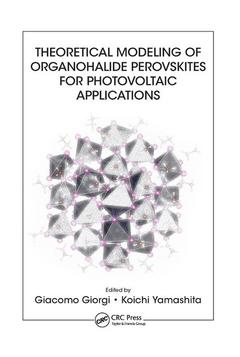Description
Theoretical Modeling of Organohalide Perovskites for Photovoltaic Applications
Coordinators: Giorgi Giacomo, Yamashita Koichi
Language: English
Subjects for Theoretical Modeling of Organohalide Perovskites for...:
Keywords
Hybrid Perovskites; Nuclear Magnetic Resonance; PV; Halide Perovskites; Solar cell; PSCs; Organic-inorganic solar cell; Band Gap; Multijunction solar cell; American Chemical Society; Hybrid organic-inorganic; GGA Calculation; Solar Cells; Alessandro Mattoni; Octahedral Rotations; Alessio Filippetti; Lead Halide Perovskites; Claudia Caddeo; Organic Inorganic Perovskite; Mao-Hua Du; DFT Calculation; Claudio Quarti; SOC; Domenico Di Sante; FE Polarization; Liang Z; Tan; Raman Spectrum; Edoardo Mosconi; PBE Functional; Giulia Grancini; Spin Texture; Alessandro Stroppa; Exciton Resonances; Paolo Barone; BPVE; Filippo De Angelis; Tolerance Factor; Silvia Picozzi; Water Splitting; Andrew M; Rappe; Perovskite Thin Films; Fedwa El Mellouhi; Ab Initio MD; Fahhad H; Alharbi; DSSCs; Carlo Motta; PCE; Sergey Rashkeev; Stefano Sanvito; Sabre Kais; Jun Haruyama; Keitaro Sodeyama; Yoshitaka Tateyama; Ivano E; Castelli; Kristian S; Thygesen; Karsten W; Jacobsen; Jacky Even; Claudine Katan; Hiroki Kawai; Koichi Yamashita
Publication date: 12-2019
· 17.8x25.4 cm · Paperback
Publication date: 06-2017
· 17.8x25.4 cm · Hardback
Description
/li>Contents
/li>Biography
/li>
Perovskites are a class of recently discovered crystals with a multitude of innovative applications. In particular, a lead role is played by organic-inorganic halide perovskites (OIHPs) in solar devices. In 2013 Science and Nature selected perovskite solar cells as one of the biggest scientific breakthroughs of that year. This book provides the first comprehensive account of theoretical aspects of perovskite solar cells, starting at an introductory level but covering the latest cutting-edge research.
Theoretical Modeling of Organohalide Perovskites for Photovoltaic Applications aims to provide a theoretical standpoint on OIHPs and on their photovoltaic applications, with particular focus on the issues that are still limiting their usage in solar cells. This book explores the role that organic cations and defects play in the material properties of OIHPs and their effects on the final device, in addition to discussing the electric properties of OIHPs; the environmentally friendly alternatives to the use of lead in their structural and electronic properties; theoretical screening for OIHP-related material for solar-to-energy conversion; and the nature and the behavior of quasiparticles in OIHPs.
Preface
Editors
Contributors
Chapter 1 Structure and Thermodynamic Properties of Hybrid Perovskites by Classical Molecular Dynamics
Alessandro Mattoni, Alessio Filippetti, and Claudia Caddeo
Chapter 2 Bulk Structural and Electronic Properties at the Density Functional Theory and Post-Density Functional Theory Level of Calculation
Claudia Caddeo, Alessandro Mattoni, Alessio Filippetti, and Mao-Hua Du
Chapter 3 Electric Properties of Organic–Inorganic Halide Perovskites and Their Role in the Working Principles of Perovskite-Based Solar Devices
Claudio Quarti, Domenico Di Sante, Liang Z. Tan, Edoardo Mosconi, Giulia Grancini, Alessandro Stroppa, Paolo Barone, Filippo De Angelis, Silvia Picozzi, and Andrew M. Rappe
Chapter 4 Alloys and Environmental Related Issues: Toward the Computational Design of Pb-Free and Stable Hybrid Materials for Solar Cells
Fedwa El Mellouhi, Fahhad H. Alharbi, Carlo Motta, Sergey Rashkeev, Stefano Sanvito, and Sabre Kais
Chapter 5 Atomic Structures and Electronic States at the Surfaces and Interfaces of CH3NH3PbI3 Perovskite
Jun Haruyama, Keitaro Sodeyama, and Yoshitaka Tateyama
Chapter 6 Computational High-Throughput Screening for Solar Energy Materials
Ivano E. Castelli, Kristian S. Thygesen, and Karsten W. Jacobsen
Chapter 7 Organic–Inorganic Halide Perovskite Quasi-Particle Nature Analysis via the Interplay
among Classic Solid-State Concepts, Density Functional, and Many-Body Perturbation Theory
Jacky Even, Giacomo Giorgi, Claudine Katan, Hiroki Kawai, and Koichi Yamashita
Index
Giacomo Giorgi is an associate professor at the Department of Civil and Environmental Engineering of the University of Perugia, Italy. He has worked at the Department of Chemical System Engineering at the University of Tokyo, where he was a postdoc and later a senior researcher in the group led by Prof. Koichi Yamashita. He was formerly an assistant professor at the Research Centre for Advanced Science and Technology (RCAST) at the University of Tokyo. His scientific interests focus on the theoretical analysis of materials for solar-to-energy conversion.
Koichi Yamashita has been a full professor at the Department of Chemical System Engineering at the University of Tokyo since 1994. He obtained both his undergraduate and graduate degrees at Kyoto University, supervised by Professor Kenichi Fukui. He worked as a postdoctoral fellow with Professor William Miller at the University of California, Berkeley. He has published more than 250 refereed journal articles in the fields of theoretical and computational chemistry.




